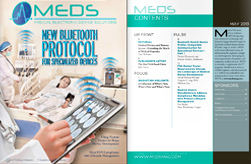On July 13, 2012, the International Electrotechncial Commission (IEC) published the first amendment to IEC 60601-1:2005, Medical electrical equipment – Part 1: General requirements for basic safety and essential performance.
by Charles Sidebottom, P.E., Secretary, IEC/SC 62A

Charles B. Sidebottom, P.E., Director, Corporate Standards, Medtronic Inc.; Secretary, IEC SC 62A; Secretary, ISO TC 150, SC 5
The objective of IEC 60601-1 is to specify general requirements applicable to medical electrical equipment and systems and to serve as the basis for other standards in the IEC 60601 series that specify requirements for particular types of medical electrical equipment or systems. IEC 60601- 1 details general and test requirements, a classification scheme and requirements for marking the documents that the manufacturer must provide for the medical electrical equipment or systems. The standard contains requirements for protection against electrical and mechanical hazards, against unwanted and excessive radiation hazards, and against excessive temperatures and other hazards from the medical electrical equipment or system.
IEC 60601-1:2005 also introduced or further integrated development process requirements for those aspects of the medical electrical equipment or system that are not amenable to classical pass/fail testing requirements. Examples are software and user interface design (usability). The third edition of IEC 60601-1 also relies heavily on the risk management process described in ISO 14971.
During the final phases of the development of IEC 60601-1:2005, the National Committee members of IEC Sub- committee (SC) 62A identified a short list of issues that emerged too late in the process to be included in the third edition. With the agreement of the National Committees, these comments were deferred to a future amendment or revision of the standard.
Within a year of its publication, SC 62A began receiving feedback from manufacturers and conformity assessment bodies (test houses) on the practical challenges they were facing in implementing and testing to the third edition. Also in 2007, the European Union revised its Medical Devices Directive to incorporate certain essential requirements from the Machinery Directive and apply them to medical electrical equipment and systems that qualified as machines within the scope of the European Machinery Directive. An examination of IEC 60601-1 found that some of these safety concerns were not as thoroughly dealt with in the standard as was needed to use a claim of compliance with the third edition to support the full presumption of conformity with the Medical Devices Directive.
By the spring of 2008, IEC Technical Committee (TC) 62 was ready to begin work on the first amendment to IEC 60601-1:2005. A four-year development plan was approved by SC 62A and formal work began in the fall of 2008.
In addition to dealing with the deferred issues and new safety requirements arising for application of the European Machinery Directive, the Technical Committee instructed SC 62A to specifically address and clarify the way in which risk management has been introduced into IEC 60601-1:2005 and the way the concept of essential performance is used in IEC 60601-1:2005.
This first item involved a thorough review of all the places in the standard where risk management is referenced to make sure terminology was correctly used, i.e., not referring to a hazard when what is meant is a hazardous situation. In the process, several references to risk management were removed because the standard already contained a verifiable requirement and the reference to risk management was unnecessary. Subclause 4.2 was substantially revised to clarify how the risk management process in ISO 14971 is to be applied within a product standard. This included clarifying that some aspects of the life cycle process described in ISO 4971 are not applicable within a design verification (i.e., type test) standard.
The concepts of functional safety em- bodied in the requirements for essential performance have proven challenging for many of the users of the third edition. To help address these concerns, the definition has been revised to stress that essential performance is about the performance
• of a clinical function,
• other than that related to basic safety, and
• where operation outside the limits specified by the manufacturer results in an unacceptable risk.
Subclause 4.3 has been expanded to outline a process the manufacturer can use to identify and document the essential performance of their medical electrical equipment or system within its intended use.
The third edition incorporated the requirements for Programmable Electrical Medical Systems (PEMS) introduced in IEC 60601-1-4:1996 into Clause 14 of the general standard. Although it is often assumed that the requirements for PEMS are just for software, they are not. The PEMS requirements apply equally to any programmable element regard- less of how it is implemented. However, recognizing that software presents common problems affecting many, perhaps most, medical electrical equipment and systems, SC 62A, in partnership with ISO/TC 210, developed a medical device software lifecycle standard—IEC 62304:2006. IEC 62304 was not mature enough to be made a normative reference in IEC 60601-1:2005. However, Amendment 1 adds a normative reference to some requirements in IEC 62304 when the PEMS includes software.
Amendment 1 also includes some much-anticipated improvements to the requirements and test procedures in Sub- clause 9.4 on instability.
Now that Amendment 1 has been published, a consolidated edition of IEC 60601-1 incorporating Amend- ment 1 is currently in preparation. Pub- lication of IEC 60601-1 Ed. 3.1 is expected shortly.

